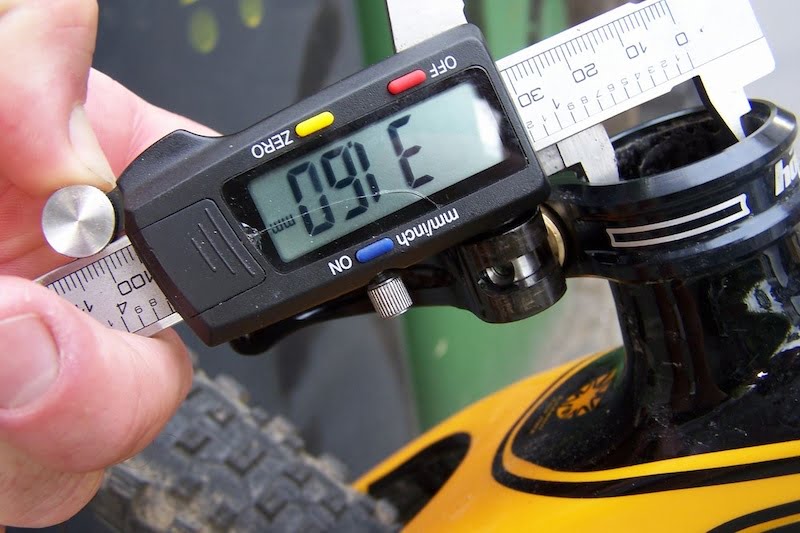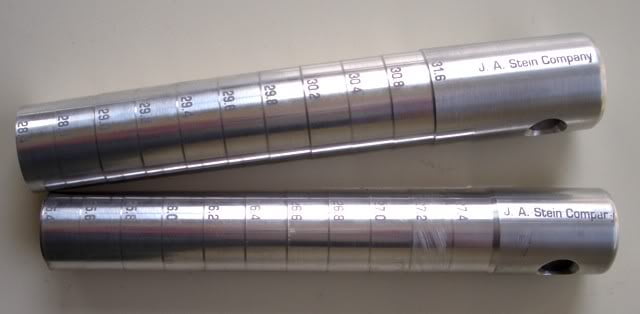To help prevent mistakes when purchasing or changing seatposts, this article explains what kinds of seatpost diameters are most commonly used and how they are measured. Only diameter (width) is dealt with here. The length of the seatpost depends on frame geometry (design) and size – i.e. how much the saddle needs to be raised from the end of the seat tube. A separate article explains the maximum amount of seatpost extension from the frame (minimal insertion length). For seatpost height in terms of bicycle fitting, see: Setting up comfortable riding position.
Table Of Contents (T.O.C.):
TL/DR
If your seatpost is too wide, it won’t fit in the frame (and will get badly stuck if you force it). If it’s too narrow, it will slip (and your frame might crack when you tighten it).
Here, I’ve explained:
- How to measure your frame and your seatpost?
- Which size standards exist?
The latter is important because if you measure 27.18 mm, for example, it’s good to know that it’s most probably the 27.2 mm standard (as the other standards are 0.2 mm apart: 27.0, and 27.4 mm).
0. Terms
It is important to understand two terms:
- “seat tube” – the tube in the frame that holds the seatpost.
- “seatpost” – the post the saddle is mounted on.
Picture 1 shows a seatpost (1), and a seat tube (2):


Pictures 1a, and 1b
1. A bit of history
The first bicycle frames were made mostly from steel, with steel tubes of a standard (outer) diameter. The British and Italian standard diameter for seat tubes was 1 1/8″ (28.6 mm). Older French bicycles used 28 mm tubing. Old US bicycles (mostly BMX and older bikes that used one-piece cranks) was 1″ (25.4 mm).
Standard outer diameter dimensions were important so that derailleur clamps etc. could be made in exact matching sizes (derailleur clamp inner diameter needs to match the seat tube’s outer diameter). Higher quality frames are usually made with thinned down tube walls to reduce the weight of the frame. This meant that a wider seatpost diameter usually meant a higher quality (and lighter) frame. So high-quality frames with 1 1/8″ seat tubes usually had 27.2 mm wide seatposts.
A more modern trend, mostly on mountain bikes, where stronger seatposts are required (without too much extra weight) led to a new “oversized” standard of 27.4 mm (and wider).
2. Measuring required seatpost diameter
“One (precise) measurement is often better than a thousand expert opinions” – author’s expert opinion. 🙂
How to measure the seatpost diameter? The easiest and most accurate method is to use calipers (Vernier, or digital), as shown in picture 2.

Source: forums.mtbr.com
Picture 2
It can be seen from picture 2 that the seatpost is marked as 31.6 mm wide (and 410 mm long), while it really measures only 31.42 mm. This means the seatpost will probably not fit firmly enough to stay in place inside a seat tube meant for 31.6 mm wide seatposts. Always measure! 🙂
Measuring a seat tube diameter is often necessary before purchasing, or changing the seatpost. How should one do that? Three methods will be explained here, but one can always be creative. 🙂
Method 1: if the frame already has a mounted matching seatpost – one that attaches firmly enough so it doesn’t slide, while being narrow enough to allow easy mounting and dismounting – then it is sufficient to measure its outer diameter, as was explained above in the section – “How to measure the seatpost diameter?”.
Method 2: using calipers, as shown in picture 3.

Source: forums.mtbr.com
Picture 3
Method 3: using special seat post sizing rods. These are rods with an increasing diameter from one end to the other, with a scale noting the diameter in standard sizes. The rod is simply placed in the seat tube and the matching diameter is the one just above the end of the seat tube (the first visible number on the rod still sticking out of the tube). Place a screwdriver through a hole at the top of the rod, just to make sure it doesn’t drop all the way in if the sizing rod is too small. 🙂

Source: bikeforums.net
Picture 4
Since measuring often can’t be done to a 1/100 of a millimeter in accuracy, the next section gives a list of the most commonly used standard seatpost diameters. If a measured diameter differs, it can be assumed that the correct diameter is the standard one that most closely matches the measured diameter.
3. Standard seatpost diameters
Table 1 gives a list (in mm) of standard diameter sizes:

Table 1
Seatpost diameters are usually a multiple of 0.2 mm (but not always, as tables 1 and 2 show). If a measured value differs and most closely matches a value that is not a multiple of 0.2, there is a high probability that the closest multiple of 0.2 mm size will fit. For example, a measured 25.5 will most probably fit a 25.4 mm wide (nominal and measured width) seatpost. A rule of thumb is that the widest post that slides in without being forced (other than pushing or twisting by hand) is the right one. If it drops in, with play, before the pinch bolt is tightened, the seatpost is probably too narrow.
A few notes, just in case:
- If a seatpost wobbles or rocks left-right (before tightening the clamp), it is probably too narrow.
- Don’t punch it in. If it can’t be eased in by hand, it’s probably too wide. Forcing it in makes it very, very difficult to move or take out later. It might even damage some frames.
For easier managing, table 2 gives an overview of seatpost diameters most commonly used on modern bicycles (from the end of the 20th century to now).

Table 2
Help BikeGremlin
stay online & independent
This website is educational, free, objective, and not commercial
(sponsors don’t enjoy paying if you mention all the product downsides that you notice 🙂 ).
How much does a WordPress website cost?
If you find this site to be good and helpful,
and if $5 per month is what you can afford to set aside,
please consider supporting my work with a Patreon donation:

The existing comments posted under this article (questions and answers) have been moved to this BikeGremlin forum thread:
https://www.bikegremlin.net/threads/seatpost-diameter-sizes-standards-article-comments.120/

Thanks again for your information. I have 2 comments. When trying to purchase a seatpost for an oversized seat-tube, I eventually noticed a comment that the seat post outer diameter should be 1mm less than the measured seat tube inner diameter, (on one of UK based online cycle shops – I forget which). That did give a snug fit, but I also note your measurements show seat post stated diameters are not exact.
Secondly in an old comment above you state.. “Anyway, when I turn .988″ into mm, it is below 20.1 mm (20.0952 to be exact).” I’m old enough to have been brought up with imperial measures in the UK, and that didn’t look right. I use 25.4mm to an inch as a rule of thumb, which gives 25.095mm for 0.988″ when I calculate. These days I also exclusively use the metric system. Except when using sites from the USA.
Regarding, measuring the internal diameter of the frame seat tube, I wouldn’t just measure at the top, as it could be splayed out. I would measure further down, as well, using a pair of internal callipers, or an inside micrometer.